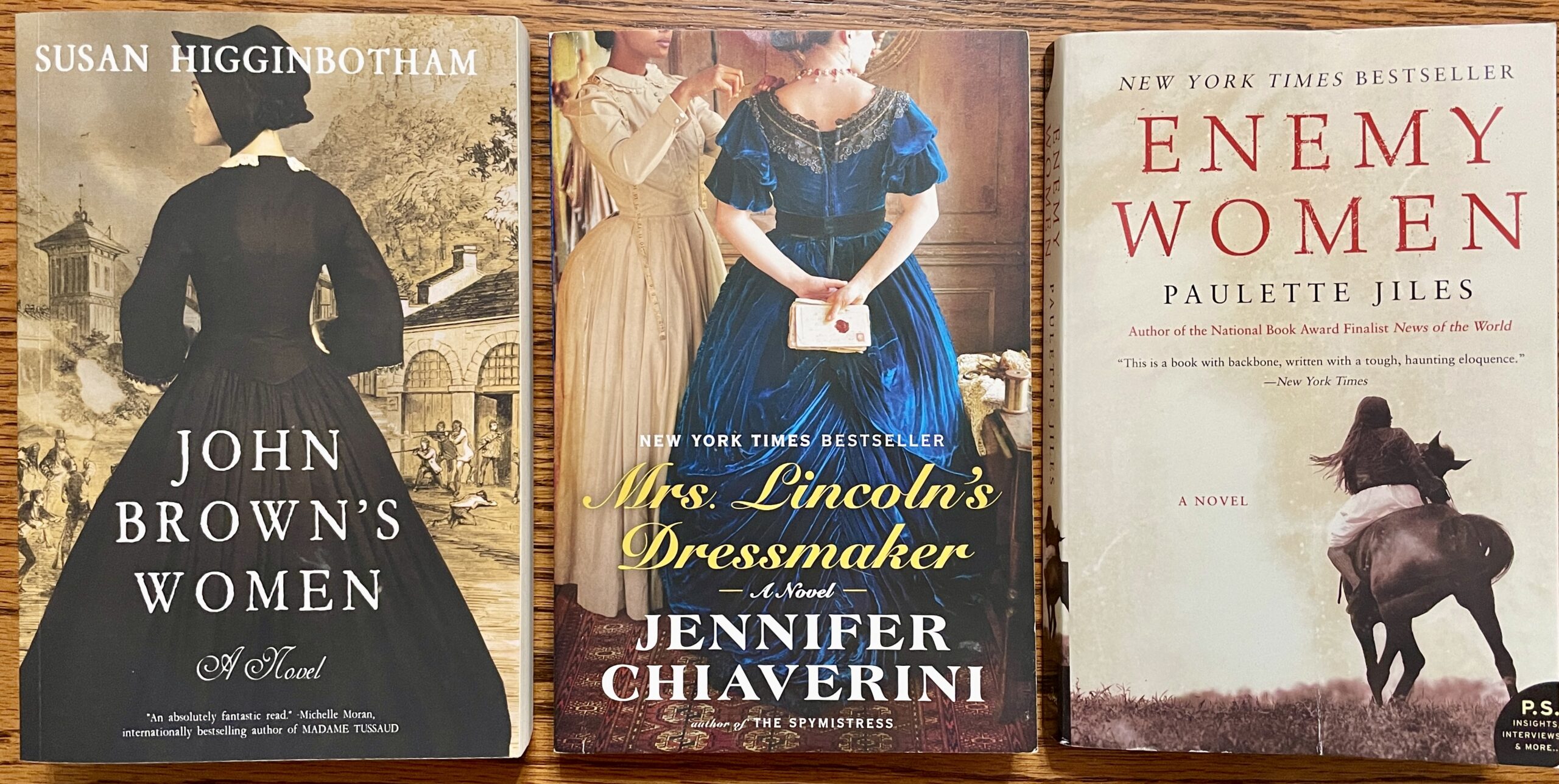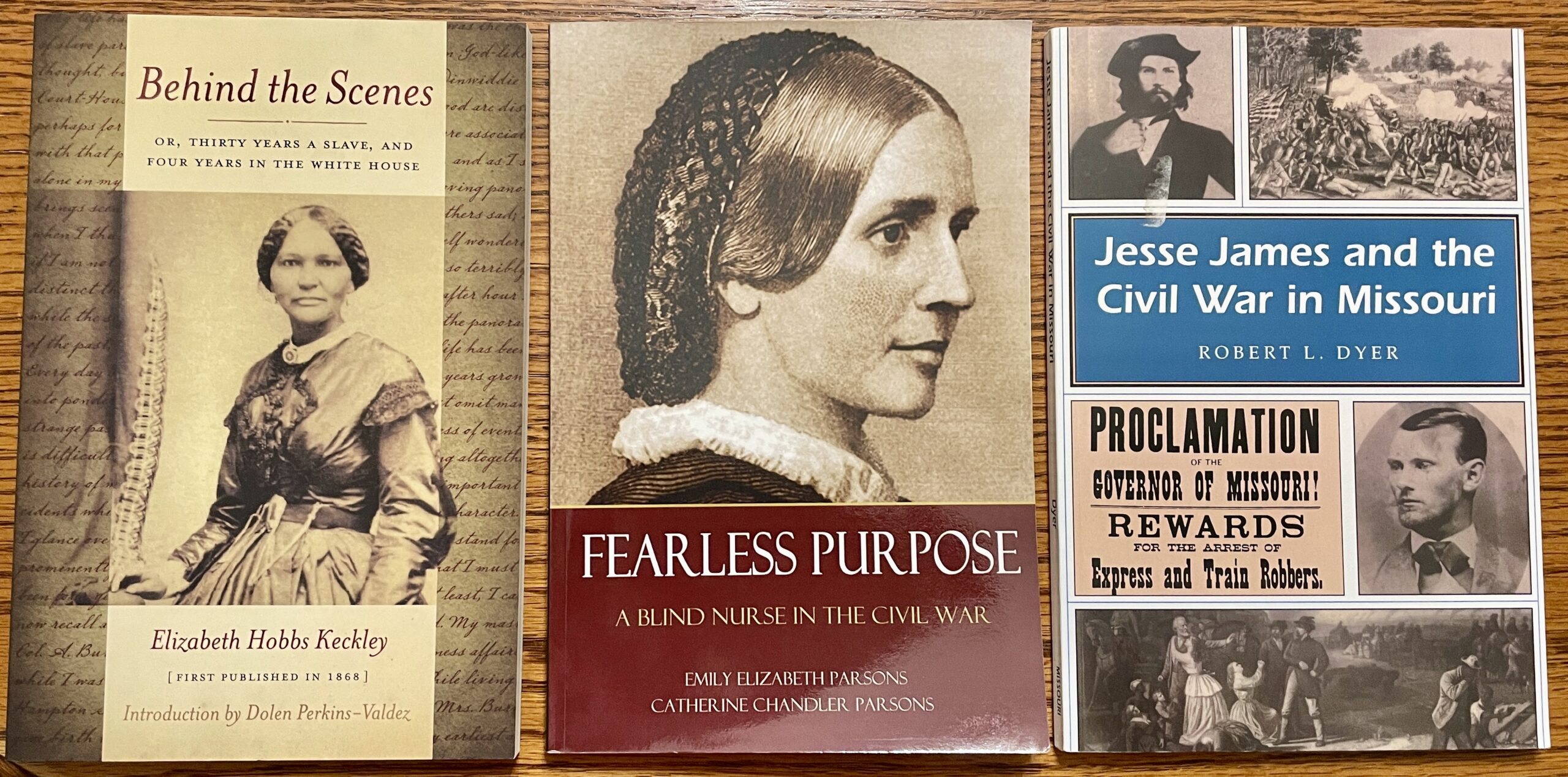Our Favorite Books: Tonya McQuade’s Top 5 Picks

As someone who has focused a lot of my Civil War research on Missouri while working on my book A State Divided: The Civil War Letters of James Calaway Hale and Benjamin Petree of Andrew County, Missouri, I found all of the following books interesting and informative. They have all added to my understanding of the war in the Trans-Mississippi theater, introduced me to new “key players” in the West, and inspired me to dig deeper into the people, locations, issues, battles, and topics they presented.

Historical Fiction:
John Brown’s Women, by Susan Higginbotham
Much has been written about the abolitionist work of John Brown, the part he played in the “Bleeding Kansas” border wars, and his disastrous raid on Harpers Ferry. His prophetic dying words anticipated the bloodshed of the Civil War, and his hanging and later burial sparked big headlines and drew large crowds. But what about the women in his life? What did his wife, daughters, and daughters-in-law, many of whom sacrificed the men they loved to his work, think of his plans and actions, as well as their costs and consequences? What did they do after he died?
In John Brown’s Women, Susan Higginbotham–having done a lot of research–gives voice to three of those women: his wife Mary Day Brown, who gave him thirteen children and helped him raise seven from his first wife; his daughter-in-law Wealthy Hotchkiss Brown, who married John Jr. and traveled with him and her father-in-law to Kansas; and his daughter Annie; who went with him to Harpers Ferry, supported his work there, and stayed almost until the end. I found it fascinating to learn their stories; hear their thoughts, hopes, fears, and frustrations (however imagined); and ponder their roles in history.
I was especially surprised to realize that Mary Brown and two of her daughters are buried in Saratoga, California, just ten miles from my home in San Jose. Higginbotham mentioned this in her “Author’s Note” at the end of the book; then, I found a book written by local author Mary Miller Chiao, titled Miss Sarah Brown: Daughter of Abolitionist John Brown, that told more about their story. Of course, I had to go visit their graves at Madronia Cemetery. I wrote about the Brown family’s decision to move to California in an ECW post last March–proving how my reading often informs and prompts my posts!
Mrs. Lincoln’s Dressmaker, by Jennifer Chiaverini
In 2012, a group of historians in Washington, D.C., decided they wanted to try something new as a way to honor Abraham Lincoln on President’s Day. They decided “to physically illustrate Lincoln’s importance by creating a tower of books written about him. The tower measure[d] about eight feet around and 34 feet — that’s three and a half stories tall…. The towering tribute to the 16th president [rose] up through the middle of a spiral staircase in the lobby of the new Ford’s Theatre Center for Education and Leadership, located just across the street.” [2]
Even at that height, the tower only included 7,000 of the more than 15,000 books that have been written about Lincoln–more than any person in world history besides Jesus Christ. But how many have been written about Mrs. Lincoln’s dressmaker, who had more access to the president and his wife than most people did during his tenure as president? Elizabeth Hobbs Keckley, a former slave, was able to buy her freedom with the money she earned making dresses for many of Washington, D.C.’s elite. She became one of Mary Todd Lincoln’s closest confidantes, even traveling with her to Illinois after her husband’s assassination. This book provides great insights into their unusual friendship, the mood swings Mrs. Lincoln experienced, the events and interactions Keckley witnessed at the White House, and the aftermath of Lincoln’s assassination.
I was excited when I visited the Lincoln President Museum and Library in Springfield, Illinois to see the figure of Elizabeth Keckley standing there behind Mary Lincoln in the dress exhibit. A copy of her autobiography, Behind the Scenes: or, Thirty Years a Slave, and Four Years in the White House, published in 1868, was also on display, as was a note she signed, “testifying to [the] authenticity” of the spoon on display as being the last one Lincoln used. She had saved it, along with some of his other personal effects. Lincoln’s wife, Mary, wasn’t always an easy person to work for, but the combination of Chiaverini’s book and Keckley’s autobiography gave me a lot of new insights into her character.

Enemy Women, by Paulette Jiles
For many civilians living in Missouri during the Civil War, the fighting didn’t just take place at distant battlefields. It happened in nearby cities, towns, and even their own front yards as guerrillas fighters on both sides–jayhawkers and bushwhackers, and even the Missouri militia–wreaked havoc throughout the countryside. In Enemy Women, 18-year-old Adair Colley, who lives in southeastern Missouri, finds herself caught up in this fighting, even though her family has tried to maintain their neutrality. Soon, she must watch as her father is beaten and taken away by soldiers, her house is burned, and her physically disabled brother is forced to go into hiding to avoid having to join the guerrillas.
Adair and her sisters set out to look for their father and find a place of safety, but instead, Adair finds herself arrested for “aiding the enemy” and transported to Gratiot Street Prison in St. Louis. There she must endure hunger, filth, cold, threats, violence, and deranged cellmates all while worrying what has become of her family. Faced with the opportunity to “confess” or escape, Adair must decide whether she wants to take her chances … and must struggle to hold onto hope that a better future lies ahead, perhaps even one that involves the Union captain she meets at the prison.
Enemy Women powerfully captures the dilemma so many civilians faced as both jayhawkers and bushwhackers made life miserable for them, often driving them from their homes with only the clothes on their backs. The brutal tactics of each side made it hard to know whom to trust, and often one side’s violent actions drove civilians to the other side. Many women whose brothers, sons, and husbands were off fighting for one side or another were branded “enemies” for providing food, clothes, shelter, and medical assistance to those same men. It was not a good time to be a woman in southeastern Missouri.

Nonfiction Titles:
Fearless Purpose: A Blind Nurse in the Civil War, by Emily Elizabeth Parsons and Catherine Chandler Parsons
I stumbled upon Fearless Purpose after visiting the Missouri Civil War Museum in St. Louis and seeing a display about Massachusetts native Emily Parsons. Though partially deaf and physically frail, Parsons arrived in St. Louis in 1863 and soon became the head nurse at St. Louis’s Benton Barracks. This was of particular interest to me because forty of the Civil War letters in my book A State Divided were written by my great-great-great-grandfather, James Calaway Hale, who spent nearly two years of his three-year enlistment at Benton Barracks. After becoming sick with dysentery and rheumatism, Hale was transferred from Helena, Arkansas, to the Benton Barracks General Hospital, where he was greeted by Emily Parsons and her team of nurses.
When I discovered this book, which includes many diary entries and letters Parsons wrote during this time, I was thrilled to discover that she wrote about some of the same people and events that Hale described. She filled in details and descriptions about the General Hospital; the sicknesses, diseases, and injuries that were treated there; and the teams of doctors, nurses, cooks, and servicemen Hale would have encountered. Prior to her tenure in St. Louis, Parsons also served on a hospital ship that traveled down the Mississippi River, stopping at Helena during the time Hale was still there before heading down to pick up sick and injured soldiers near Vicksburg.
As head nurse at the hospital, Parsons dramatically transformed the military hospital’s operations by improving conditions and lowering the fatality rate among the sick and wounded. She did all this despite the fact that, due to an injury when she was young, Parsons was blind in one eye and had poor vision in the other; had limited hearing ability due to the effects of scarlet fever; and suffered pain in her ankle due to another injury as a young woman. Parsons also contracted malaria while serving on the hospital ship and continued to suffer from bouts of related illness for the rest of her life. Read more about her in this earlier ECW post I wrote.
Jesse James and the Civil War in Missouri, by Robert L. Dyer
When most people hear the name Jesse James, they think of the famous outlaw who led his gang in a series of robberies that sometimes involved killings and always garnered headlines. Through the years, some have portrayed him as a criminal, some as a hero, some as a victim. When I visited the Jesse James House in St. Joseph Missouri, I saw the bullet hole in the wall marking the place where he was shot by former gang member Robert Ford. I also saw lots of family photos, memorabilia, and news stories about his past escapades. However, I was actually there to do research for my book on the Civil War in Missouri.
As I mentioned earlier, guerrilla fighting made up a lot of the warfare in Missouri–and this book explains how Jesse James, along with his brother Frank James and their friends the Younger brothers–got their start as Confederate bushwhackers during the Civil War. They rode at various times with Confederate guerrilla leaders William Clarke Quantrill, George Todd, and William “Bloody Bill” Anderson. Jesse James saw some of his first major action at the battle of Centralia, which I also wrote about in an earlier ECW post. There, the 17-year-old James claimed to have been the one to shoot Union Maj. Andrew Vern Emen Johnston. I also wrote about Cole Younger in another ECW post, this one discussing the unusual friendship he formed with Union Maj. Emory Foster at the battle of Lone Jack, again driven to do further research by what I was learning from the book I was reading.
Jesse James and the Civil War in Missouri provides a great introduction to the guerrilla fighting that occurred in Missouri. If you want to further expand on that knowledge, I recommend you read Tom Goodrich’s Black Flag: Guerrilla Warfare on the Western Border and Michael Fellman’s Inside War: The Guerrilla Conflict in Missouri During the American Civil War. All make for interesting reading!
Endnotes:
- Staff, NPR. “Forget Lincoln Logs: A Tower Of Books To Honor Abe.” NPR, 20 February 2012, https://www.npr.org/2012/02/20/147062501/forget-lincoln-logs-a-tower-of-books-to-honor-abe.
- Ibid.

I’m still waiting for a full history of the James-Younger Gang, since most just focus on the people. How about them as a group?
If you missed my earlier post about Cole Younger, you might want to check it out. I did find it rather fascinating to discover the friendship he formed with Union Major Emory Foster: https://emergingcivilwar.com/2023/07/19/a-surprising-friendship-formed-at-lone-jack-union-major-emory-foster-and-bushwhacker-bank-robber-cole-younger/
Also, seeing your last name, I have to ask if you are related to James Calaway Hale, my 3rd great grandfather, who wrote the letters in my book “A State Divided.” Any connection? His father was Meshack Hale, and his father was Shadrach Hale. (And yes, there were also some Abednegos in the family tree!)